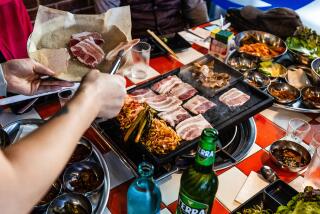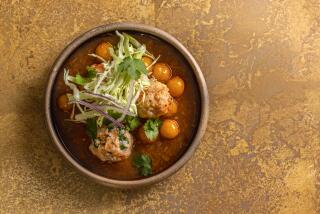Going gluten-free more common, but not necessarily easier
For more than 20 years, Kristine Kidd tasted what came her way as the food editor at Bon Appetit magazine. But she never felt great.
“I had digestive issues my whole life,” she says, but 21/2 years ago, the aching joints, bloating, fatigue and digestive problems became so severe she couldn’t ignore the symptoms of celiac disease.
She had already left her job and started doing some research, she says in the roomy, sunny kitchen of her hilltop home in Topanga Canyon.
FOR THE RECORD:
Gluten-free foods: An article May 18 about maintaining a gluten-free diet misidentified Melinda Dennis of Beth Israel Deaconess Medical Center in Boston as Melissa Dennis. —
“I was so miserable. And as soon as I went gluten-free, the symptoms started to subside,” she adds, as she prepared shrimp in tomato sauce over polenta, a recipe from her book “Weeknight Gluten Free.” In four months, she felt healthy.
Living a gluten-free life has become easier now that the conditions underlying the intolerance can be diagnosed. There are hundreds upon hundreds of products available, as well as a growing number of restaurants willing to accommodate diners who avoid gluten.
But easier doesn’t mean easy. One wrong bite can mean a week feeling lousy.
“I’m happy that I don’t feel like I’m dying, but ... I’m still angry and resentful,” says Carol Blymire, a writer in Washington, D.C., who for a time wrote the blog “Gluten for Punishment.”
CHAT: Chef Kristine Kidd talks about cooking and eating gluten-free
She’s not alone. It is estimated that 1% of the population has celiac disease and a greater number of people suffer from wheat allergies or are gluten-intolerant, says Melissa Dennis, the nutrition coordinator at the Celiac Center at Beth Israel Deaconess Medical Center in Boston. In addition, consumer research from the NPD Group suggests that nearly one-third of Americans want to reduce or eliminate the gluten in their diets.
Thanks are due in part to the Paleo, low-carb and “wheat belly” diets, to the never-ending desire to lose weight (though a gluten-free diet is no guarantee of that) and to celebrities such as Gwenyth Paltrow. “Saturday Night Live” poked fun of going gluten-free as a “made up allergy that you invented to get attention” — just the sort of joke to make the celiac community cringe.
“Gluten-free has maintained this steady growth, but it has shifted in the reason why so many consumers are interested,” says Melissa Abbott, senior director, culinary insights at the market research firm Hartman Group. “Consumers don’t even know why they’re doing it often.”
That can be a little annoying to people who have no choice.
“Part of me resents them because they’ll go to restaurants and say everything has to be gluten-free, then nibble on their friends’ bread,” says Blymire, whose condition means she needs to avoid using even a shared microwave oven. “I’ve gotten accidentally ‘glutened’ six or seven times, and it’s excruciating.”
Nonetheless, consumer desires, and dollars, mean that the list of gluten-free foods, which include quinoa pasta, brown rice cereals and mung bean noodles, continues to grow. Evol makes burritos and other frozen entrees without gluten. Blue Diamond makes rice-and-almond crackers. Way Better Snacks produces chips with corn, flax and chia seeds.
Udi’s, the big player in the gluten-free kitchen, has grown in the last three years from $6 million in sales to an expected $130 million this year, says its vice president of marketing, Denise Sirovatka. Its whole grain sandwich bread is its biggest seller, and a frozen baguette has just been launched in limited distribution.
Many consumers are trying gluten-free products without professional medical advice, she says. “People hear about it and self-diagnose. If it works for them, they stick with it.”
But a gluten-free diet is not inherently a healthful one. Some products are no more healthful than “your classic processed foods,” Dennis says. “They’re adding salt and fat to make up for the mouth feel and texture of gluten, and they’re lower in minerals and fiber.”
Leslie Cerier, author of “Gluten-Free Recipes for the Conscious Cook,” suggests people branch out to grains such as amaranth, new spices and lots of produce.
For breakfast, “think beyond toast. You can have a variety of different porridges with millet or rolled oats, or quinoa. Top with coconut milk or yogurt, maple syrup,” she says.
Kidd cooks with lots of polenta, made from corn, and quinoa. She turns scrambled eggs into crepes and makes the naturally gluten-free French flatbread called socca.
Eating out can be a challenge, and Kidd says restaurant kitchens don’t always know what to do: Cooks will put gluten-free pasta into the same water they use for wheat pasta, for instance. In L.A., Kidd returns to the same restaurants; when she travels, she carries bags of gluten-free flour that she gives chefs for her meal. “In the beginning, I was very uncomfortable at restaurants, but if you don’t stand up for yourself once and you get really sick, then you know.”
Even the vaunted French Laundry in the California Wine Country has heard the gluten-free call, and chef Thomas Keller asked his research and development chef, Lena Kwak, to find a solution. After a lot of trial and error to replicate the complex role of flour in baking, the result was Cup4Cup, a gluten-free mix now available in stores.
And there’s hope for beer drinkers who want to avoid gluten.
New Planet, one of several gluten-free beer makers, uses sorghum to replace barley and is coming out with a brown ale in August. Omission beer, which uses traditional barley but removes the gluten after brewing, came on the market a year ago.
“Being able to sit down with someone and have them want to drink the same beer I’m drinking is really fun,” says Terry Michaelson, chief executive of Omission, who has celiac disease. “I’m beginning to understand how important beer is to people and understand the passion gluten-free consumers have when they learn, wow, I can drink this. It’s a really fun experience.”
More to Read
Eat your way across L.A.
Get our weekly Tasting Notes newsletter for reviews, news and more.
You may occasionally receive promotional content from the Los Angeles Times.







